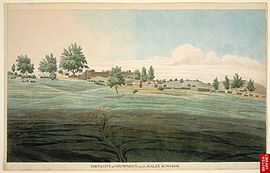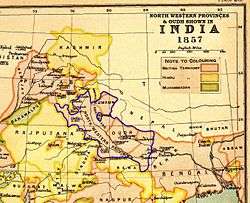Kumaon Kingdom
Kumaon Kingdom was an independent Himalayan kingdom in the eastern region of present-day Uttarakhand state of India established around 7th century and remained independent sovereign kingdom until 1791[1][2].
Kingdom of Kumaon | |||||||||
|---|---|---|---|---|---|---|---|---|---|
| 7th century–1791 | |||||||||
 Flag | |||||||||
Kumaon Kingdom in 1765 from the Imperial Gazetteer of India | |||||||||
| Status |
| ||||||||
| Capital | |||||||||
| Common languages | Kumaoni, Sanskrit | ||||||||
| Religion | Hinduism | ||||||||
| Demonym(s) | Kumaoni | ||||||||
| Government | Monarchy | ||||||||
| Maharaja | |||||||||
• 700 | Vasudev Katyuri (first) | ||||||||
• 1791 | Mahendra Chand (last) | ||||||||
| History | |||||||||
• Established | 7th century | ||||||||
| 1791 | |||||||||
| |||||||||
| Today part of | |||||||||
| Princely state |
|---|
| Individual residencies |
|
| Agencies |
|
| Lists |
History
Ancient
Kumaon finds mention in the early Hindu scriptures as Manaskhand, according to Skanda Purana the region is believed to be the Birth place of Kurma avtar of Hindu god Vishnu[3].
Prehistoric dwellings and Stone Age implements have been discovered in Almora and Nainital districts. Initially settled by Kol tribals, the region witnessed successive waves of Kiratas, Khasas and Indo-Scythians. Kunindas were the first rulers of the region.
Katyuri dynasty
Around 700CE. Katyuri dynasty established by Vasudev in the region They called their state Kurmanchal, the land of Kurma, the second avatar of Vishnu, from which the present name is derived. capital was Kartikeypura(morden day-Baijnath)[1][4] and the Gomati Valley came to be known as the Katyur Valley after the ruling dynasty.[1] during their reign they dominated lands of varying extent from the "Katyur" (modern-day Baijnath) valley in Kumaon, between 7th and 11th centuries C.E., and established their capital at Baijnath in Bageshwar district; which was then known as Kartikeyapura and lies in the centre of "Katyur" valley. Brahmadev mandi (a trading and business center in a flat area of the then Katyuri dynasty) in the Kanchanpur District of Nepal was established by Katyuris king Brahma Deo. Brahmadeo Mandi still exists by this name.
At its peak, the Katyuri dynasty of kumaon extended from Sikkim in the east to Kabul, Afghanistan in the west, before fragmenting into numerous principalities by the 12th century.[5] it is believed that from king Dham Deo and Vir Deo the downfall of this powerful dynasty began. Virdeo used to collect heavy taxes and forced his people to work as his slaves, King Virdeo teased his subjects by his tyranny to the extent that he forcibly married his own maternal aunt Tila(Tilottama Devi). It is said that the Kumaoni folk song 'Mami tile dharo bola' became popular from that very day[1].
Chand dynasty

Sometime in the 10th century, the Chand dynasty was established by Som Chand, by displacing the Katyuri Kings. He continued to call his state Kurmanchal, and established its capital in Champawat in Kali Kumaon. The Baleshwar and Nagnath temples were built in this city during the 11th and 12th centuries.[6] During this period, learning and new forms of painting (the pahari school of art ) developed.[7].
Conflicts and battles
Towards the end of the 17th century, the Kumaon kings attacked Garhwal. In 1688, Udyot Chand, erected several temples at Almora, including Tripur Sundari, Udyot Chandeshwar and Parbateshwar, to mark his victory over Garhwal and Doti. The Parbateshwar temple was renamed twice, to become the present Nanda Devi temple. Gyan Chand, the king of kumaon ascended the throne in 1698. In 1699 he invaded Garhwal, which was under the king Fateh Shah . He crossed Ramganga river and plundered Sabli, Khatli, and Sainchar. In 1701, Fateh shah entered in Chaukot (now Syalde region with 3 part, Talla Chaukot (lower), Malla Chaukot (Upper) and Bichla Chaukot (middle)) and Gewar valley (region of Chaukhutiya, Masi, and Dwarahat) as reply. The Kumaonis defeated the Garhwalis in the battle of Duduli (near Melchauri in Garhwal). In 1707, the Kumaon forces annexed Juniyagarh in Bichla Chaukot (Syalde), and razed the old fort at Chandpur. Few years Later, Jagat Chand (1708–20), invaded Garhwal, defeated the ruling king of Garhwal and expelled him from Srinagar, his kingdom was given to a Brahmin.[8]
Nepalese invasion and its defeat
In the latter half of the 18th century, the power of Kumaon was on decline, as the king Mahendra Chand was unable to properly administer the country and conflicts with other neighbouring kingdoms,natural calamities,intrigues and dissensions further weakened the kingdom.
Seeing this opportunity, in 1791 the Gorkhas invaded over Kumaon. Gorkha army led by the Gorkha commanders Bahadur shah , kazi Jagjit Pande, Amar Singh Thapa and Sursingh Thapa set to attack kumaon from doti, One regiment went from Kali to Sor, another set out to capture Visung. When the news of the sudden invasion reached Almora, King Mahendra Chand summoned his troops and taking a contingent with him moved towards Gangoli. contingent advanced towards Kali Kumaon.
Amar Singh Thapa with his troops attacked the Kumaoni contingent but the forces of king Mahendra chand defeated him and compelled him to turn towards Baitadi, however few hours later gorkha army in large numbers surrounded kumaon from all the direction of west, king mahendra chand fled thus gorkhas finding their path clear reached and captured almora and Kumaon was annexed to Gorkha Kingdom.[1]
The Gorkha rule over Kumaon lasted for 24 years, and has been termed as "Cruel and Oppressive" in a number of texts. The only architectural advancements during the period was a road connecting kali river to Srinagar via Almora.
Kumaon Province

The Gorkhas were defeated by the East India Company in Anglo-Nepalese War and were forced to cede Kumaon to the British as part of the Treaty of Sugauli in 1816. The Kumaon region was joined with the eastern half of the Garhwal region and was governed as a chief-commissionership, also known as the Kumaon Province, on the non-regulation system.[9] In seventy years it was governed by three successive administrators: Mr. Traill, Mr J. H. Batten and Sir Henry Ramsay. The British set up a small administrative unit to govern the region, known as Patwari Halka.[10]
Kumaoni culture
Kumaoni language
The Kumaoni language is one of the Central Pahari languages. For a number of reasons, Kumaoni usage is shrinking rapidly. UNESCO's Atlas of the World's Languages in Danger designates Kumaoni as a language in the unsafe category which requires consistent conservation efforts.[11]
Rulers
References
- Omacanda Hāṇḍā (2002). History of Uttaranchal. Indus Publishing. pp. 72–. ISBN 978-81-7387-134-4. Retrieved 22 July 2012.
- Atkinson, Edwin T. (Edwin Thomas), 1840-1890. (1990). Himalayan Gazetter. Cosmo. OCLC 183008777.CS1 maint: multiple names: authors list (link)
- KAFALTIA, HIMANSHU KAFALTIA, GUNJAN SHARMA (18 September 2019). A Comprehensive Study of UTTARAKHAND. Notion Press. ISBN 978-1-64650-605-7.
- "History of Kumaon". Archived from the original on 13 March 2012. Retrieved 22 July 2012.
- "9th-11th century". Archived from the original on 20 April 2008. Retrieved 9 June 2008.
- History Of Kumaon - Brahmins From Kumaon Hills
- Pande, B. D. (1993). History of Kumaon: English version of "Kumaon ka itihas". Almora, U.P., India: Shyam Prakashan: Shree Almora Book Depot
- Hunter, William Wilson, 1840-1900. (1885–87). The imperial gazetteer of India ... Trübner. OCLC 24165771.CS1 maint: multiple names: authors list (link) CS1 maint: date format (link)
- Robert Montgomery Martin, History of the Possessions of the Honourable East India Company, Volume 1, pg. 107
- Brief History of the Kumaon Regiment from the official site of the Indian Army
- "UNESCO Interactive Atlas of the World's Languages in Danger". UNESCO. Retrieved 3 September 2010.